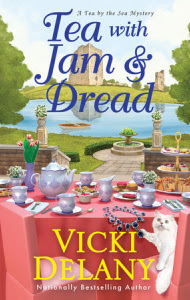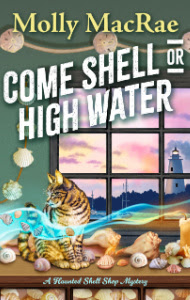by Sheila Connolly
I'm a sucker for old cookbooks. You know, those tattered, stained ones you find at flea markets and yard sales for a dollar each. They offer wonderful insights into how people used to eat, and, indirectly, what products were available. Among my favorites are:
How to Cook Casserole Dishes, by Marion H. Neil (1912), which the author opens with the statement, "There is no doubt that the fashion of cooking in casseroles has come to stay in this country." You think? In the rest of the 200+ page book the author managed to put just about anything you can imagine in a casserole format–the first picture includes a skinned rabbit.
Mary Arnold's The Century Cook Book (1896), which in addition to recipes includes detailed instructions on etiquette and presentation and offers chapters on "Cooking as a Pleasure and an Accomplishment" and "To Train a Green Cook" (the frontispiece shows a table set for fourteen with a lace tablecloth).
The Settlement Cookbook (23rd edition, 1940) by Mrs. Simon Kander (she gets an author photo up front) which includes on the cover "The way to a man's heart". This is a well-organized book, with alphabetical tabs and multiple indexes.
But recently in a prowl in a local antique store I came upon a December 1914 copy of American Cookery (formerly The Boston Cooking-School Magazine of Culinary Science and Domestic Economics). Two things intrigued me: first, the advertisements, many of which were for products that are still available, and that I have in my own pantry: Cream of Wheat, Crisco, Carnation Milk, Knox Gelatine, and Ivory Soap, to name a few. (I could go on, but this is about food).
The second thing that I found interesting was an article titled "Censoring the Christmas Dinner." It's told as a story, in which Mrs. John Smith, married to the "American John Smith", has declared war on foreign food products. The writer, Stella Burke May, goes on to say, "the Smith household was being constantly menaced by the air fleet of Imported Products...which has dropped a High-Cost-of-Living bomb." Remember that the First World War had just begun in July of that year, although the US was not yet part of it. In any event, Mrs. Smith, presumably for both patriotic and economic reasons, decides to eliminate all foreign elements from her Christmas Dinner menu, using only products grown or produced in the US (she drew from a surprisingly broad geographic range, from California to Florida, but she had to fudge a bit to include Brazilian coffee).
Alas, Mrs. May did not include any recipes. But since I am always on the lookout for new (to me) apple recipes, I did find an interesting one in another article by Janet M. Hill (who just happened to be the editor of the magazine, and who contributed multiple articles).
Let me note that Janet, while provided the recipes, didn't both to talk about pesky details like oven temperature or cooking time, so I had to make some educated guesses. And the cake pan she suggested–six by twelve inches–is not a modern size. I found that this recipe fits nicely into a nine-inch square pan.
Apple Custard Cake
Cake:
1 3/4 cups flour
½ tsp salt
4 level tsp baking powder
½ cup sugar
1/4 cup (½ stick) butter
1 egg
1 cup milk
3 apples
3 Tblsp currants
sugar for sprinkling (about 1/4 cup)
Custard:
2 Tblsp butter, softened
1 egg, well beaten
3 Tblsp sugar
½ cup milk
½ tsp vanilla extract
Preheat the oven to 350 degrees.
Butter the baking pan. Sift together the dry ingredients for the cake. Work in the butter with two knives/a pastry cutter/a food processor. Beat the egg lightly and stir it into the batter along with the milk.
Peel and core the apples and slice them thinly. Lay them on the cake batter in rows (narrow edge down). Strew the currants over the apples and sprinkle with sugar.
Place in preheated oven and bake for 30-35 minutes.
While the cake is baking, make the custard. Beat the egg. Cream the butter, then beat in the sugar, then the beaten egg, the milk, and the vanilla.
When the cake is set but not browned, open the oven and pull out the rack with the cake on it (Janet says, do not remove the cake from the oven) and pour the custard over it. Return the cake to the oven and finish baking, for another 15-20 minutes. The cake will be done when the custard layer is lightly browned.
Confession: I tried this recipe according to Janet Hill's rather vague instructions, and the result may be better suited to 1914 tastes than to ours: it was doughy and not very sweet. I made some changes, and my version produces an almost puddingy texture. It also makes a difference what kind of apples you use. I'd recommend a fairly soft apple, like a Macintosh or a Golden Delicious (the latter holds its shape well in cooking).
I almost recommended cooking this at a higher temperature, but I'm not sure the apples would cook through before the batter did. Feel free to experiement–and report back!
 Krista had a funny post last week about neighbors sneaking paper bags full of garden veggies onto doorsteps.
Krista had a funny post last week about neighbors sneaking paper bags full of garden veggies onto doorsteps. ![RileyAdamsFoodBlogPostpic_thumb_thumb[3] RileyAdamsFoodBlogPostpic_thumb_thumb[3]](http://lh6.ggpht.com/-QPTV0DfaiPg/Tll6Iafzs5I/AAAAAAAADA4/hxnt5MZ0rJU/RileyAdamsFoodBlogPostpic_thumb_thumb%25255B3%25255D_thumb%25255B31%25255D.jpg?imgmax=800)







































![RileyAdamsFoodBlogPostpic_thumb_thumb[3] RileyAdamsFoodBlogPostpic_thumb_thumb[3]](http://lh4.ggpht.com/-QKJFVkVRBdY/TllzIzGvdVI/AAAAAAAADAo/EaAFUAHJ8Os/RileyAdamsFoodBlogPostpic_thumb_thumb%25255B3%25255D_thumb%25255B25%25255D.jpg?imgmax=800)




















![RileyAdamsFoodBlogPostpic_thumb_thumb[3] RileyAdamsFoodBlogPostpic_thumb_thumb[3]](http://lh6.ggpht.com/-_VIDUHG7zBw/TlRRXx-uH-I/AAAAAAAAC_8/lxhudkjo8a8/RileyAdamsFoodBlogPostpic_thumb_thumb%25255B3%25255D_thumb%25255B18%25255D.jpg?imgmax=800)
























